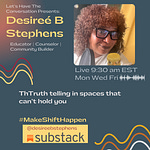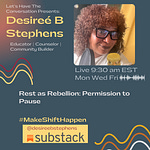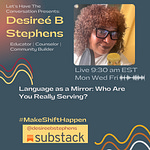A Sacred Contextual Anchor
Let’s begin with this quote from
of Soul Science Healing, which speaks directly to the heart of today’s teaching:“Our bodies are hardwired for joy and connection. Going as far back as we can find, humans have been gathering together to celebrate life and death and find safety and meaning together. The ventral vagal nervous system state we achieve in safe moments literally promotes a longer, healthier lifespan.”
— Nicole Rubin, Soul Science Healing
“Joy is not the absence of pain. It is the presence of safety.”
— Desireé B. Stephens
How Collective Joy Heals the Nervous System and the Narrative
They told us to regulate, but forgot to tell us how.
They taught us “self-care” but skipped community.
They said, “heal yourself,”
but never admitted that the systems were the sickness.
So what do we do?
We dance.
We laugh.
We gather.
We reclaim joy as somatic medicine.
Not just for the mood, but for the body. Not just for ourselves, but for the collective.
Joy is not a luxury, it’s ancestral.
It’s not a privilege, it’s a birthright.
It’s not disconnection from reality, it’s a radical return to what is most true about being alive and in community.
Three Core Takeaways
1. Joy Regulates the Nervous System
When we’re stuck in survival (hypervigilant, anxious, numb) joy becomes a signal of safety.
It tells your body: “You’re allowed to soften. You are not in danger.”
Example: That full-belly laugh you shared with a friend that made you lose your breath? That was your vagus nerve getting a hug. That was your cortisol taking a nap.
Reframe: Joy is not earned through struggle. Joy is a regulation tool.
It’s what we need to stay present, grounded, and whole.
Reflection Prompt:
Where do I feel safe enough to exhale? What spaces or people help me return to my body?
2. Joy is Contagious and Communal
Our nervous systems are social. That means one person’s regulation can create a ripple of safety for others. This is why joy spreads in rooms, it’s not just emotional; it’s neurobiological.
Example: Think back to a moment of group joy: a spontaneous dance party, church laughter, shared karaoke, joyful potlucks. Your brain remembers that not as spectacle, but as connection.
Reframe: Healing doesn’t always happen on a massage table or a therapist’s couch.
Sometimes it’s in a circle of aunties cackling while braiding hair.
Sometimes it’s in the rhythm of synchronized footsteps at a protest.
Reflection Prompt:
Who is in my joy circle? When have I felt co-regulated in joy with others?
3. Joy Disrupts and Rewrites the Trauma Narrative
Trauma says: “You’re alone. You’re unsafe. You don’t get to feel good.”
Joy interrupts that with: “You’re here. You’re loved. You’re worthy of delight.”
Example: When you plan Joychella even while your child’s school threatens to expel him; THAT is medicine. That is a refusal to wait for permission to feel joy. That’s ancestral defiance.
Reframe: Joy is not the opposite of grief. Joy is what gives grief space to breathe. It is the crack in the narrative where hope sneaks in and whispers, “This is not the end of your story.”
Reflection Prompt:
What old story is ready to die so that joy can take root in its place?
Featured Video Clip (Timestamp: 28:15–31:00)
“Joy is a collective nervous system reset.”
In this moment from the podcast, Desireé explains how even moments of shared laughter or dance create a shared field of healing. That isn’t fluff—it’s ancestral tech.
“When we feel joy together, our nervous systems sync. We’re no longer alone in the regulation. And that, beloveds, is how we start to heal systems—by healing each other.”
🔐 Paywall Section Begins Here
To my subscribers: thank you for helping build sustainable, liberatory, sacred work. Your support isn’t just financial, it’s energetic, communal, and deeply appreciated.
Let’s embody what we know.












